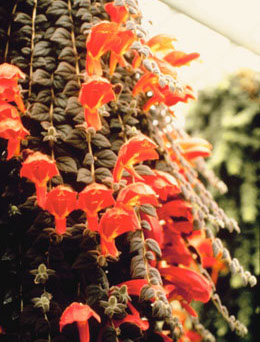The goldfish plant truly lives up to its name, by flaunting its vibrant orange flowers which radiate from the plant's glossy green foliage. Know more about this beautiful plant and how to give it the utmost care and attention from this article.

This plant gets its name from the brilliantly gorgeous orange flowers that resemble a goldfish. The arching back of the eye-catching orange blossoms of the plant, to which the tail is attached, gives them the identical features of a goldfish. To add to this, these blossoms reach a length of 3 inches, which makes them all the more similar. Unlike other plants, this one needs a little more attention. It is endemic to Brazil, Costa Rica, and the southernmost regions of Mexico. The following segment is a brief description on how to take good care of this piece of natural beauty.
Care Tips
The goldfish plant is one of the thirsty plant species and therefore must be kept moist at all times. However, care must be taken that the soil does not get soggy. Misting the plant daily using a spray bottle helps in taking care of its humidity needs and makes way for a healthy foliage. However, the water must not have a heavy concentration of lime. Basically, the soil must be uniformly moist. In periods of inactive growing, decrease the watering to allow the soil to dry out slightly. You will know if you are overwatering your plant if the leaves begin to develop black spots on them. You can also increase the humid conditions for the plant by placing pebbles or gravel in the drainage dish of the pot to hold water. Do not let the pot sit on the water, instead place it on the gravel.
Choose a spot for the plant which is nicely lit with indirect sunlight. If you notice the leaves beginning to curl up, then it may be a symptom of inadequate sunlight. It is advisable that you keep your plant near an east or south-facing window. Here, it will get all the light it needs, without being subjected to the risk of direct sunlight.
An important aspect of the care is using it as a hanging plant. Placing it outdoors might cost it its health and beauty. However, it may be kept under the care of a greenhouse, where it will have the required warmth and humidity it requires for its growth.
The plant does good in warmer temperature. A temperature above 60 degree is good enough. Not to mention, keep it away from vents and drafty areas.
It may happen that your plant might lose flowers with no signs of new blossoms. In such a case, enclose and secure it in a plastic bag after watering and place it in indirect sunlight. This is a kind of greenhouse effect that you're providing to the plant and this method should encourage it to begin flowering once again within a few weeks.
Plant cuttings can be used for propagation of the plant. The best time for this is considered to be the period between springtime and the end of summer. Get rich potting soil which contains peat and perlite. Press the cuttings gently into the soil and make sure that the potting mix covers the cuttings. Water the pot well and use a plastic bag in order to encase it completely. This is to keep the moisture from evaporating. Thereafter, place the pot in a well-lit area, free of direct sunlight. Do not remove the plastic covering until the plants have attained a good establishment.
Use a lime-less fertilizer that can be easily dissolved in water (on a weekly basis). During periods of rest, i.e., when the plant goes into a hibernating mode, you may stop feeding until it starts to grow again.
Although this variety needs an extra bit of care and attention, its delightful beauty all year around, is sure worth the effort to put in.






 This plant gets its name from the brilliantly gorgeous orange flowers that resemble a goldfish. The arching back of the eye-catching orange blossoms of the plant, to which the tail is attached, gives them the identical features of a goldfish. To add to this, these blossoms reach a length of 3 inches, which makes them all the more similar. Unlike other plants, this one needs a little more attention. It is endemic to Brazil, Costa Rica, and the southernmost regions of Mexico. The following segment is a brief description on how to take good care of this piece of natural beauty.
This plant gets its name from the brilliantly gorgeous orange flowers that resemble a goldfish. The arching back of the eye-catching orange blossoms of the plant, to which the tail is attached, gives them the identical features of a goldfish. To add to this, these blossoms reach a length of 3 inches, which makes them all the more similar. Unlike other plants, this one needs a little more attention. It is endemic to Brazil, Costa Rica, and the southernmost regions of Mexico. The following segment is a brief description on how to take good care of this piece of natural beauty.